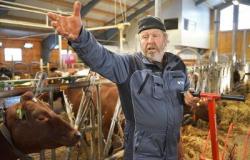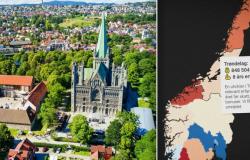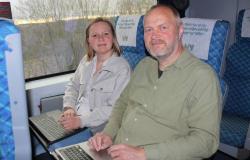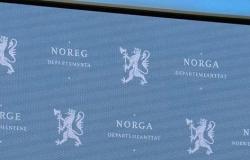Climate change is felt on our houses. Moisture and rot damage occurs faster than before.
There is therefore a great need for high-quality materials in wood. Materials that can be left untreated on new buildings and to restore old ones.
Now a new project will use technology to find the right materials.
– The house behind me has a panel that we have called climate panel. And the ambition has been to manage to sort out heartwood from pine that is extra durable and can withstand the new climate, says Dagfinn Claudius.
200 year old trees
He is project manager for “Climate panel” in Innlandet county municipality.
Today, 200-year-old solid trees are mixed with 70-year-old trees after clear-cutting.
The young trees have almost the same resistance to fungus and rot.
Therefore, it is demanding to find the really good materials. No one has control over where they are used.
– The best materials are mixed with inferior materials and sold cheaply at the timber sales. It’s a waste of good quality. We are therefore advocating for better sorting, says Claudius.
STUDENT THREE: Dagfinn Claudius, project manager for “Climate panel” in Innlandet county municipality and architect Lasse Haldrup Juul is concerned with finding materials that can be left untreated decade after decade.
WEATHER-HARD: The side that receives the most precipitation and wind has been given the wooden panel that is most resistant to fungus and rot.
CAREFULLY SELECTED: The timber is X-ray scanned and the planks are chemically analyzed before they are selected.
PROJECT MANAGER: Dagfinn Claudius in Innlandet county council is eager for better sorting of timber.
Thorough analyses
The project has scanned the timber that was to be used with a large X-ray machine.
They then carried out chemical analyzes of the various planks.
This was done to find the panel tables with the most heartwood. In other words, those that will be most resistant to weather and wind.
This has never been done on a house project in Norway before.
X-RAY: Here the timber is sent into the X-ray scanner.
LARGE PLANT: The images of the logs can then be analyzed on the computer screen.
SAMPLES: The next step was to take samples of the various planks.
CAREFUL SELECTION: These were then chemically analyzed to find the planks with the best resistance to fungus and rot.
Sustainable
Lasse Haldrup Juul is the architect in the project.
He joined because he is keen to develop products with a sustainable profile.
– I want wood that lasts longer and preserves its naturalness and glow. If it can happen without the use of lots of chemicals and plastic, then I am very satisfied, he says.
The architect sees several advantages for the consumer in using a solid untreated wall panel.
You don’t have to paint the house. You avoid using a lot of chemicals and you prevent the paint from hiding the formation of rot.
At the same time, he points out that there is not an inexhaustible stock of materials that can withstand more extreme weather. This is therefore just one of several solutions for the house of the future.
Less clearingand more closed felling can provide a greater selection of high-quality timber in the future.
Will sort the timber better
In retrospect, it has been shown that the chemical analyzes of the planks are the most precise way of finding the heartwood.
And more research is needed to further develop the methods.
The house at Gjøvik will probably be checked every five years to see how the panel develops in relation to houses with panels that have not been selected using this method.
MUST STAND TOUGHER CLIMATE: The hope is that the panel will be able to stand untreated and exposed to weather and wind for decades after decades.
Tags: technology find durable materials houses
-





